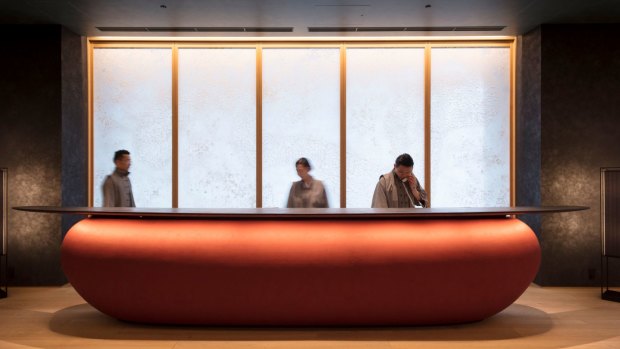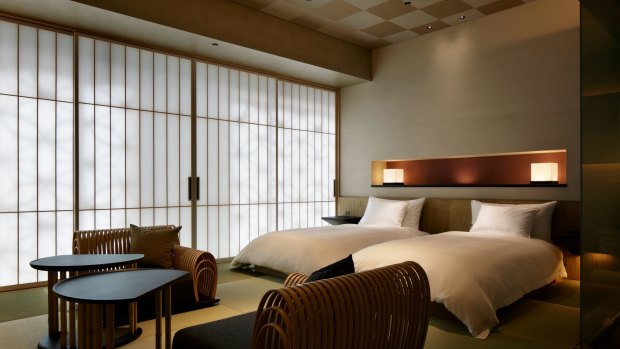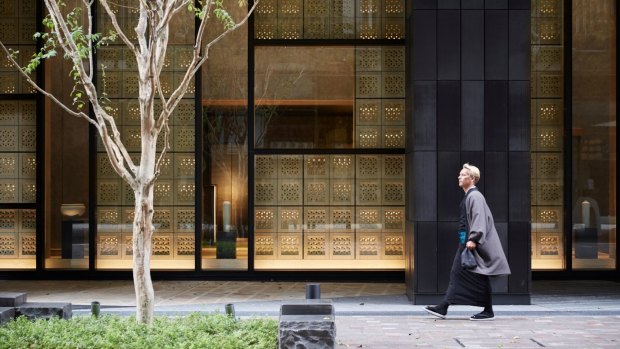This was published 4 years ago
Hoshinoya Tokyo, Japan hotel review: A traditional Japanese inn reinvented for city living
By Amelia Lester

The front desk at Hoshinoya Tokyo.Credit: Masashi Kuma
THE PLACE
The 84-room Hoshinoya Tokyo, which opened in 2016, has achieved the impossible: a ryokan, or traditional Japanese inn, experience in the heart of the city. Hoshino Resorts is an upscale Japanese chain focused on local culture and tradition, and theirs is the only hotel in Tokyo with an on-site onsen, or hot spring. The emphasis on relaxation makes the Hoshinoya an outstanding choice for the leisure traveller looking to recharge.
THE LOCATION

The Cherry Blossom (Sakura) room.
The hotel is spread across 17 floors in the CBD, next to Tokyo Station. There's no sign, nor a lobby, and the premises – including the restaurant and onsen – are open only to guests. (Taxi drivers can find it tricky to locate.) Although the area itself is predominantly offices, the expansive grounds of the Imperial Palace are across the road.
THE SPACE
The seemingly anonymous black box of a building reveals an intricate carved pattern of hemp leaves up close. This attention to detail extends to the interior, which is covered in tatami mats and decorated in a minimalist Japanese style. Each floor has six rooms, which share a communal lounge area with free tea, coffee, beer and Tokyo-themed snacks such as fruit jellies and rice crackers.

The hotel is spread across 17 floors in the CBD, next to Tokyo Station. Don't expect a sign.Credit: Hoshinoya Tokyo
The onsen pumps water from 1500 metres below to the top floor of the hotel. The facilities are communal but separated by sex. Each features an indoor, black-walled bath with a double-height skylight and an outdoor bath with a panoramic view of the city. A small adjacent spa offers oil massage treatments which are particularly therapeutic for jet lag.
THE ROOM
There is no hierarchy of accommodations; instead, the three room categories are based purely on size, ranging from 40 to 83 square metres. All are decorated in soft greys and neutrals with outside light filtered through shoji (rice paper screens). The Kiku (Chrysanthemum) room is the largest and is designed for a couple or a family of three. The bed, on a chestnut-wood platform above the tatami, is between a traditional tatami mattress and a Western-style one in terms of height and softness.
The sofa in the Kiku room is generously sized, enough for a third guest to sleep on comfortably. The sofa, bed and tables are all at the same level, encouraging a floor-level style of relaxation, as is traditional in Japan. All rooms have bamboo wardrobes and bathtubs, but in the Kiku, the tub is Japanese-style, which means you can soak up to your shoulders. The in-house skincare line is exquisite and involved, with five steps of products for morning and night.
Following ryokan custom, Hoshinoya Tokyo provides guests with clothes to wear, all in soft linen: an apricot-colored pair of pyjamas, charcoal-grey button-down loungewear and an elegant grey and black yukata, or robe. Shoes are not permitted in the hotel.
THE FOOD
The unnamed restaurant in the building's basement serves "Nippon Cuisine," the invention of executive chef Noriyuki Hamada. His style involves French techniques and Japanese ingredients, and celebrates the seasons, with a focus on seafood. The 10-course dinner is served in one of six private dining rooms decorated with fossilised wood from the pillars of the feudal mansion which once stood on this site. The plating showcases handcrafted ceramics, urushi lacquer, wood and metal from Japanese artisans. Five flavours of delight, the restaurant's signature dish, is a series of meticulously crafted bite-sized creations, including a sea bream tartare, croquette of chrysanthemum greens with whelk and escargot butter, and a persimmon and cream-cheese paste steamed in a root vegetable pouch.
Breakfast is included and served mostly in-room. There are both Western and Japanese options. Both are served in tiered wooden bento boxes. The Japanese breakfast is an array of tastes: fish, tamagoyaki (a kind of rolled egg dish with a sweet taste), yuba (tofu skin), seaweed, miso, rice, a gold-flecked flan, and fruit.
STEPPING OUT
Ryokans are all about immersive sensory experiences aimed at total relaxation. As a result, guests mostly do not leave after checking in, and take all meals inside. Activities offered free on site include workshops on the art of incense, Japanese court music performances (known as gagaku), evening sake tastings, and morning exercise classes using a katana, or wooden sword. For a fee, guests can participate in a tea ceremony or, pending availability, meet with sumo wrestlers.
Rickshaw rides from the hotel are offered to local attractions which include the Imperial Palace and its park, Marunouchi shopping area, and the charming Kanda and Nihonbashi districts. Anywhere farther afield can be reached easily through the subway and train hub of Tokyo Station next door.
THE VERDICT
An unforgettable cultural experience which restores body and spirit.
ESSENTIALS
Rooms from $892 a night. See hoshinoya.com/tokyo
HIGHLIGHT
Soaking in mineral-rich water amidst the twinkling lights of Tokyo.
LOWLIGHT
Your credit card bill after the serenity of the stay has worn off.
Amelia Lester stayed as a guest of Hoshinoya Tokyo.
Sign up for the Traveller Deals newsletter
Get exclusive travel deals delivered straight to your inbox. Sign up now.